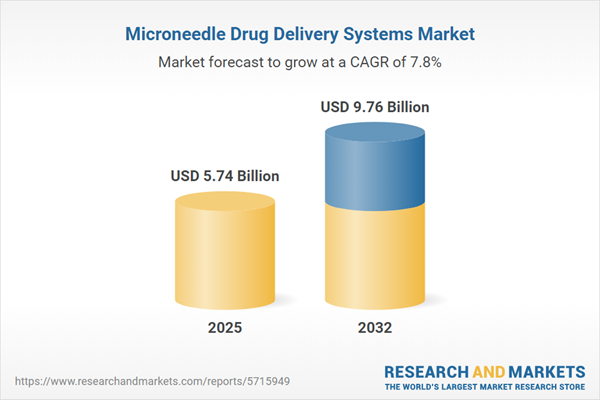Speak directly to the analyst to clarify any post sales queries you may have.
The microneedle drug delivery systems market stands at a pivotal point for senior decision-makers seeking reliable, strategic market intelligence. Clear trends in therapeutics innovation, regulatory alignment, and supply chain shifts are redefining this sector globally, presenting a compelling landscape of both opportunities and challenges.
Market Snapshot: Microneedle Drug Delivery Systems Market Overview
The Microneedle Drug Delivery Systems Market grew from USD 5.35 billion in 2024 to USD 5.74 billion in 2025. It is expected to continue growing at a CAGR of 7.80%, reaching USD 9.76 billion by 2032. The primary keyword, microneedle drug delivery systems market, anchors this report’s strategic focus. This sector is characterized by robust growth momentum as advances in targeted and minimally invasive therapeutics continue to gain traction among healthcare providers and pharmaceutical manufacturers. Senior executives are increasingly prioritizing this market given accelerating adoption rates, expanding clinical utility, and widening regional uptake across global healthcare infrastructures.
Scope & Segmentation: Comprehensive Insights Into Global and Segment Dynamics
This report delivers actionable intelligence by segmenting the microneedle drug delivery market along key dimensions that matter most for informed decision-making:
- Product Types: Dissolving microneedles, hollow microneedles, hydrogel-forming microneedles, and solid microneedles, each offering differentiated technology features and end-use applications.
- Material Types: Ceramics (including alumina and zirconia), metals (stainless steel and titanium), and polymers (poly lactic-co-glycolic acid, polylactic acid, polyvinylpyrrolidone). Material selection influences performance, bio-compatibility, and manufacturing requirements.
- Applications: Cancer therapy, dermatology, pain management, and vaccine delivery, reflecting the breadth of therapeutic areas addressed by innovative microneedle solutions.
- End-User Environments: Ambulatory surgical centers, diagnostic laboratories, home healthcare, hospitals and clinics, life science and research laboratories, with each setting driving specific usability and compliance demands.
- Regions: Americas (North America, Latin America), EMEA (Europe, Middle East, Africa), and Asia-Pacific, highlighting the nuanced regional drivers influencing adoption pathways.
- Key Players Profiled: Major companies include Becton, Dickinson and Company, ASTI Corporation, AbbVie Inc., FUJIFILM Holdings Corporation, Johnson & Johnson Services Inc., Medtronic PLC, NanoPass Technologies Ltd., Vaxess Technologies, Inc., among others.
Key Takeaways: Strategic Guidance for Senior Executives
- Ongoing innovation in microneedle fabrication, ranging from micro-molding to two-photon polymerization, is reshaping device precision and usage potential for complex therapies.
- Regulatory frameworks have evolved with new guidance for biocompatibility and sterility, accelerating regulatory approvals and spurring deeper collaboration between industry and government.
- Investment in local manufacturing and supply chain diversification is becoming critical for managing cost volatility and improving resilience, particularly in light of shifting global tariff policies.
- The market's scope has broadened beyond vaccines to include pain management, oncology, and dermatological uses, reflecting flexible technology platforms that can be aligned with diverse clinical needs.
- Strategic alliances and licensing agreements are driving portfolio expansion, supporting rapid pipeline advancement, and creating synergies for commercialization.
Tariff Impact: Navigating Economic and Supply Chain Variables
In 2025, tariff adjustments in the United States affected import costs across ceramic, metal, and polymer-based microneedle components. Manufacturers responded by advancing local production capabilities, diversifying sourcing, and exploring alternative raw materials. Contract renegotiations and extended lead times have led stakeholders to adopt agile, regionally focused supply chain models and to prioritize supply resilience.
Methodology & Data Sources
This research integrates primary interviews with market experts and stakeholders, thorough reviews of scientific literature and patent data, and robust data triangulation. Cross-verification and scenario analysis ensure credible, reproducible findings and offer clarity on segmentation, regulatory changes, and tariff influences.
Why This Report Matters: Empowering Strategic Decisions
- Enables stakeholders to benchmark against leading market strategies and anticipate emerging technology trends within microneedle drug delivery systems.
- Provides deep segmentation analysis, supporting targeted product development and tailored regional approaches to maximize return on investment.
- Illuminates supply chain and regulatory complexities, allowing executives to proactively navigate policy, cost, and operational considerations.
Conclusion: Outlook and Strategic Direction
Decision-makers positioned for success will align R&D, regulatory engagement, and commercial alliances to fully capitalize on advances in microneedle drug delivery technologies. The insights here support confident navigation of a rapid-evolving, transformative healthcare landscape.
Additional Product Information:
- Purchase of this report includes 1 year online access with quarterly updates.
- This report can be updated on request. Please contact our Customer Experience team using the Ask a Question widget on our website.
Table of Contents
3. Executive Summary
4. Market Overview
7. Cumulative Impact of Artificial Intelligence 2025
List of Figures
Samples

LOADING...
Companies Mentioned
The key companies profiled in this Microneedle Drug Delivery Systems market report include:- Becton, Dickinson and Company
- ASTI Corporation
- AbbVie Inc.
- AdminMed nanoBioSciences LLC
- Aesthetics Biomedical, Inc.
- Anodyne Nanotech, Inc.
- Biolinq Incorporated
- CeraVx
- CosMED Pharmaceutical Co., Ltd.
- Delpor, Inc.
- DermapenWorld by Equipmed USA LLC
- FUJIFILM Holdings Corporation
- Gylden Pharma Limited
- Hisamitsu Pharmaceutical Co., Inc.
- Johnson & Johnson Services Inc.
- Kindeva Drug Delivery L.P.
- LTS Lohmann Therapie-Systeme AG
- Medrx Co., Ltd.
- Medtronic PLC
- Micron Biomedical, Inc.
- Micropoint Technologies Pte Ltd
- NanoPass Technologies Ltd.
- PharmaTher Holdings Ltd.
- QuadMedicine
- Raphas Co., Ltd.
- SeriTech
- Sorrento Therapeutics, Inc.
- TheraJect, Inc.
- Valeritas Inc by Zealand Pharma
- Vaxess Technologies, Inc.
- Vaxxas
- Verndari, Inc.
- Vetter
Table Information
| Report Attribute | Details |
|---|---|
| No. of Pages | 191 |
| Published | October 2025 |
| Forecast Period | 2025 - 2032 |
| Estimated Market Value ( USD | $ 5.74 Billion |
| Forecasted Market Value ( USD | $ 9.76 Billion |
| Compound Annual Growth Rate | 7.8% |
| Regions Covered | Global |
| No. of Companies Mentioned | 34 |









